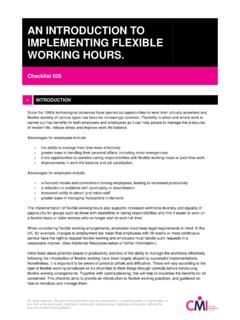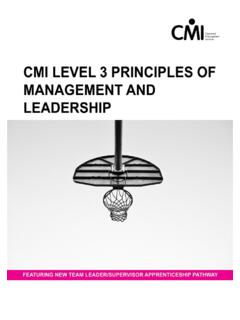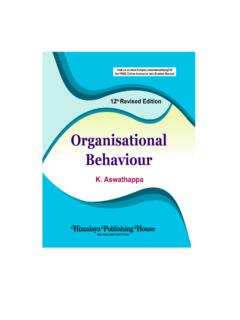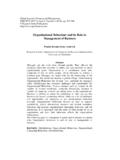Transcription of UNDERSTANDING ORGANISATIONAL CULTURE.
1 All rights reserved. No part of this publication may be reproduced in a retrieval system, or transmitted, in any form or by any means, electronic, mechanical, photocopying, recording or otherwise, without the prior permission of the publisher. UNDERSTANDING ORGANISATIONAL culture . Checklist 232 INTRODUCTION The culture of an organisation is its personality and character. ORGANISATIONAL culture is made up of shared values, beliefs and assumptions about how people should behave and interact, how decisions should be made and how work activities should be carried out. Key factors in an organisation s culture include its history and environment as well as the people who lead and work for it. An UNDERSTANDING of ORGANISATIONAL culture is essential for effective leadership. Leaders and managers will be better placed to implement strategy and achieve their goals if they understand the culture of their organisation.
2 Strategies that are inconsistent with ORGANISATIONAL culture are likely to meet with resistance and will be more difficult or even impossible to implement, while strategies that are in line with it will be easier to put into effect and more likely to succeed. It is also important to understand the existing culture of an organisation when thinking of introducing changes. It is often difficult to specify what exactly drives a particular culture , but easier to observe its effects for example, the culture of an informal small software company may be quite different from that of a large financial corporation and different again from that of a hospital or a university. It can take years for new joiners to fully understand and absorb the culture , or this may happen relatively rapidly the extent to which the organisation has a successful on-boarding approach will be important here.
3 However, in certain circumstances, an influx of new employees, especially at senior levels, can modify the existing culture . In practice it should also be recognised that while an organisation may have an umbrella culture broadly defining how things should be done and what is acceptable subsidiary cultures can emerge based on work roles or other allegiances. Inevitably culture is experienced and interpreted subjectively by individuals in the context of their own beliefs, and also their perspective on the organisation - some facets may have more relevance for some people than others depending on their roles. To gain an UNDERSTANDING of the culture of an organisation, its written and unwritten rules should be examined alongside the relationships, values and behaviours displayed by its people. This checklist begins by outlining some well-known approaches proposed by management theorists to classify ORGANISATIONAL cultures.
4 These suggest the dimensions you should look at when assessing expressions of culture in a particular organisation. Secondly, key steps to follow and questions to ask to help you gain this UNDERSTANDING are presented. DEFINITION ORGANISATIONAL culture is the way that things are done in an organisation, the unwritten rules that influence individual and group behaviour and attitudes. Factors which can influence ORGANISATIONAL culture include: the organisation's structure, the system and processes by which work is carried out, the behaviour and attitudes of employees, the organisation s values and traditions, and the management and leadership styles adopted. All rights reserved. No part of this publication may be reproduced in a retrieval system, or transmitted, in any form or by any means, electronic, mechanical, photocopying, recording or otherwise, without the prior permission of the publisher.
5 Approaches to UNDERSTANDING ORGANISATIONAL culture A number of management thinkers have studied ORGANISATIONAL culture and attempted to classify different types of culture . The following approaches may be helpful in assessing and UNDERSTANDING the culture of an organisation, but also illustrate its inherent complexity. Observers should recognise that an organisation s culture can be viewed from multiple angles, and that its characteristics can be reflected in a number of overlapping dimensions. Edgar Schein believed that culture is the most difficult ORGANISATIONAL attribute to change and that it can outlast products, services, founders and leaders. Schein s model looks at culture from the standpoint of the observer and describes ORGANISATIONAL culture at three levels: Artefacts - ORGANISATIONAL attributes that can be seen, felt and heard by the uninitiated observer, including the facilities, offices, d cor, furnishings, dress, and how people visibly interact with others and with ORGANISATIONAL outsiders Espoused values - the professed culture of an organisation's members.
6 Company slogans, mission statements and other operational creeds are useful examples Basic underlying assumptions - which are unseen and not consciously identified in everyday interactions between ORGANISATIONAL members. Even people with the experience to understand this deepest level of ORGANISATIONAL culture can become accustomed to its attributes, reinforcing the invisibility of its existence. Geert Hofstede is well-known for his work exploring the national and regional cultural influences which affect the behaviour of organisations (see Related Models and Thinkers). He also collaborated with Bob Waisfisz to develop an ORGANISATIONAL culture Model, based on empirical research and featuring six dimensions. These are: Means oriented vs goal oriented - the extent to which goals (the what ) or the means (the how) of conducting work tasks are prioritized.
7 This may affect attitudes to taking risks or contributing discretionary effort Internally driven vs externally driven - externally driven cultures will be more pragmatic, focusing primarily on meeting the customer s requirements, while internally driven cultures may exhibit stronger values Easygoing vs strict - stricter cultures run on a high level of discipline and control, while easygoing cultures tend towards more improvisation Local vs professional - the extent to which people identify with their immediate colleagues and conform to the norms of this environment, or associate themselves with a wider group of people and practices based on their role Open system vs closed system the extent to which newcomers are accepted and the differences they bring are welcomed Employee-oriented vs work-oriented the extent to which the employee s well-being is prioritised at the expense of the task, or vice versa.
8 Charles Handy links ORGANISATIONAL structure to ORGANISATIONAL culture . Handy describes: Power culture - power is concentrated among a few with control and communications emanating from the centre. Power cultures have few rules and little bureaucracy; decision making can be swift Role culture - authority is clearly delegated within a highly defined structure. Such organisations typically form hierarchical bureaucracies where power derives from a person's position and little opportunity exists for expert power Task culture - teams are formed to solve particular problems with power deriving from expertise Person culture - here, all individuals believe themselves superior to the organisation. As the concept of an organisation suggests that a group of like-minded individuals pursues common ORGANISATIONAL goals, survival can become difficult for this type of organisation.
9 However, looser networks or contractual relationships may thrive with this culture . Gerry Johnson and Kevan Scholes developed the Cultural Web in 1992. It is a representation of the taken-for-granted assumptions of an organisation which helps management to focus on the key factors of culture and their impact on strategic issues. This can identify blockages to and facilitators of change in order to improve performance and competitive advantage. All rights reserved. No part of this publication may be reproduced in a retrieval system, or transmitted, in any form or by any means, electronic, mechanical, photocopying, recording or otherwise, without the prior permission of the publisher. The Cultural Web contains six inter-related elements: Stories - the past and present events and people talked about inside and outside the company Rituals and routines - the daily behaviour and actions of people that signal acceptable behaviour Symbols - the visual representations of the company including logos, office decor and formal or informal dress codes ORGANISATIONAL structure - includes structures defined by the organisation chart, and the unwritten lines of power and influence that indicate whose contributions are most valued Control systems - the ways that the organisation is controlled including financial systems, quality systems, and rewards Power structures - Power in the company may lie, for example, with one or two executives, with a group of executives or a department, or it may be more evenly distributed in a flat ORGANISATIONAL structure.
10 These people have the greatest amount of influence on decisions, operations, and strategic direction. ACTION CHECKLIST A broad initial impression of an organisation s culture can be gained by: 1. Reading: the organisation s vision, mission and value statements, as well as documents setting out the its strategy and objectives publications, reports and newsletters. Reflect on what is mentioned, emphasised or omitted and how the organisation presents itself the organisation s website and intranet, including its presence, (or lack of presence) on social media platforms. 2. Reviewing the organisation s context and environment How might the organisation s sector (public/ private/ not-for-profit) affect its culture ? Does the industry have particular characteristics which could affect the way that people think and behave? What does the organisation s formal structure look like?
















